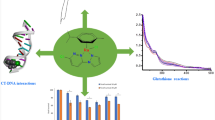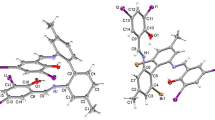Abstract
The CuII coordination chemistry of three synthetic analogues of westiellamide (H3Lwa) with an [18]azacrown-6 macrocyclic structure and imidazole (H3L1), oxazole (H3L2), or thiazole (H3L3) heterocyclic donors in addition to the peptide groups, is reported. The Nheterocycle–Npeptide–Nheterocycle binding sites are highly preorganized for the coordination to CuII ions. The stability constants of mono- and dinuclear CuII complexes of H3L1, H3L2, and H3L3, obtained by isothermal titration microcalorimetry, are reported. EPR and NMR spectroscopy as well as electrospray ionization mass spectrometry (ESI-MS) were used to characterize the complexes formed in solution. The stabilities of the mononuclear and dinuclear CuII complexes of the three ligands are in the range of 105 M−1, but there are subtle differences; specifically the oxazole-derived ligand has, in contrast to the other two macrocycles, a negative formation entropy for coordination to the first CuII ion and a higher stability for complexation to a second CuII center in comparison with the first CuII center (cooperativity). Differences between the three ligands are also apparent in terms of the formation mechanism. With the oxazole-based ligand H3L2, NMR spectroscopy, EPR spectroscopy, and ESI-MS indicate the formation of a ligand–CuII 2:1 intermediate, and this may explain the differences in the formation entropy as well as the cooperativity.






Similar content being viewed by others
Notes
Note that the considerable differences in the relative concentrations of ligand, CuII, and base, specifically also in the type and concentration of the base, are expected to lead to significant differences in the stability and relative concentrations of the various possible species observed in solution.
In the Hamiltonian H, g is the gyromagnetic matrix, A is the hyperfine matrix, B is the magnetic field, I is the nuclear spin, S is the electron spin, β is the electronic Bohr magneton, and β n is the nuclear Bohr magneton.
References
Wipf P, Venkatraman S, Miller CP, Geib SJ Angew Chem (1994), 106:1554, Angew Chem Int Ed Engl (1994) 33:1516
Degnan BM, Hawkins CJ, Lavin MF, McCaffrey EJ, Parry DL, van den Brenk AL, Watters DJ (1989) J Med Chem 32:1349
van den Brenk AL, Byriel KA, Fairlie DP, Gahan LR, Hanson GR, Hawkins CJ, Jones A, Kennard CHL, Moubaraki B, Murray KS (1994) Inorg Chem 33:3549
Comba P, Cusack R, Fairlie DP, Gahan LR, Hanson GR, Kazmaier U, Ramlow A (1998) Inorg Chem 37:6721
Grondahl L, Sokolenko N, Abberate G, Fairlie DP, Hanson GR, Gahan LR (1999) J Chem Soc Dalton Trans 1227
Bernhardt PV, Comba P, Fairlie DP, Gahan LA, Hanson GR, Lötzbeyer L (2002) Chem Eur J 8:1527
van den Brenk AL, Tyndall JDA, Cusack RM, Jones A, Fairlie DP, Gahan LR, Hanson GR (2004) J Inorg Biochem 98:1857
Li Y-M, Milne JC, Madison LL, Kolter R, Walsh CT (1996) Science 274:1188
Wipf P, Fritch PC, Geib SJ, Sefler AM (1998) J Am Chem Soc 120:4105
Krebs HC (1986) In progress in the chemistry of organic natural products. Springer, Vienna, p 151
Wipf P, Miller CP (1992) J Am Chem Soc 114:10975
Comba P, Gahan LR, Haberhauer G, Hanson GA, Noble CJ, Seibold B, van den Brenk AL (2008) Chem Eur J 14:4393
Haberhauer G, Drosdow E, Oeser T, Rominger F (2008) Tetrahedron 64:1853
Chen ASC, Wadsö I (1982) J Biochem Biophys Methods 6:307
Saboury AA (2004) J Therm Anal Calorim 77:997
Sivaraja V, Kumar TKS, Rajalingam D, Graziani I, Prudovsky I, Yu C (2006) Biophys J 91:1932
Tinoco AD, Valentine AM (2005) J Am Chem Soc 127:11218
Creagh AL, Tiong JWC, Tian MM, Haynes CA, Jeferies WA (2005) J Biol Chem 280:15735
Wiseman T, Williston S, Brandts J, Lin L (1989) Anal Biochem 179:131
Spinc C, Wadsö I (1976) Methods Biochem Anal 23:1
Haberhauer G, Rominger F (2003) Eur J Org Chem 3209
Hanson GR, Noble CJ, Benson S (2009) Molecular Sophe, An integrated approach to the structural characterization of metalloproteins, The next generation of computer simulation software in Hanson GR, Berliner LJ (eds) High resolution EPR: applications to metalloenzymes and metals in medicine. Biol Magn Reson 28:105–173
Frisch MJ, Trucks GW, Schlegel HB, Scuseria GE, Robb MA, Cheeseman JR, Montgomery JA, Vreven T Jr, Kudin KN, Burant JC, Millam JM, Iyengar SS, Tomasi J, Barone V, Mennucci B, Cossi M, Scalmani G, Rega N, Petersson GA, Nakatsuji H, Hada M, Ehara M, Toyota K, Fukuda R, Hasegawa J, Ishida M, Nakajima T, Honda Y, Kitao O, Nakai H, Klene M, Li X, Knox JE, Hratchian HP, Cross JB, Adamo C, Jaramillo J, Gomperts R, Stratmann RE, Yazyev O, Austin AJ, Cammi R, Pomelli C, Ochterski JW, Ayala PY, Morokuma K, Voth GA, Salvador P, Dannenberg JJ, Zakrzewski VG, Dapprich S, Daniels AD, Strain MC, Farkas O, Malick DK, Rabuck AD, Raghavachari K, Foresman JB, Ortiz JV, Cui Q, Baboul AG, Clifford S, Cioslowski J, Stefanov BB, Liu G, Liashenko A, Piskorz P, Komaromi I, Martin RL, Fox DJ, Keith T, Al-Laham MA, Peng CY, Nanayakkara A, Challacombe M, Gill PMW, Johnson B, Chen W, Wong MW, Gonzalez C, Pople JA (2004) Gaussian 03. Gaussian, Wallingford
Acknowledgement
Generous financial support from the German Science Foundation (DFG) is gratefully acknowledged.
Author information
Authors and Affiliations
Corresponding author
Electronic supplementary material
Below is the link to the electronic supplementary material.
Rights and permissions
About this article
Cite this article
Comba, P., Dovalil, N., Haberhauer, G. et al. Complex formation and stability of westiellamide derivatives with copper(II). J Biol Inorg Chem 15, 1129–1135 (2010). https://doi.org/10.1007/s00775-010-0673-7
Received:
Accepted:
Published:
Issue Date:
DOI: https://doi.org/10.1007/s00775-010-0673-7




